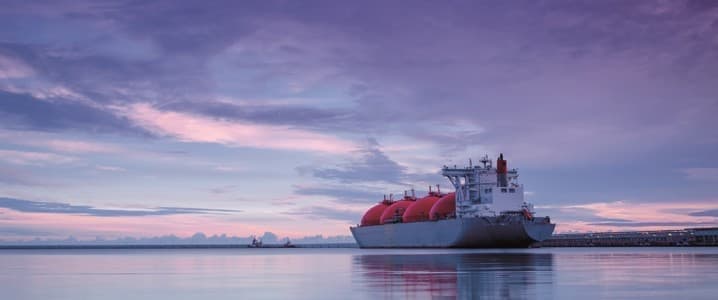The Real Ramifications Of China’s LNG Deal With Qatar
By Simon Watkins – Mar 31, 2021, 6:00 PM CDT
Last week’s signing of a 10-year purchase and sales agreement by the China Petroleum & Chemical Corp. (Sinopec) and Qatar Petroleum (QP) for 2 million tonnes per annum (mtpa) of liquefied natural gas (LNG) shifts the Emirate even more decisively into the Iran-China-Russia sphere of influence. This deal brings together the world’s top LNG exporter with one of the world’s top holders of gas reserves, both of which were founding members of the now 11-member Gas Exporting Countries Forum (GECF) together with Russia. The deal also further inextricably links this huge combined global gas resource with the world’s biggest buyer of energy products over the past two decades or more. On every level it considerably adds to the geopolitical challenge faced by the U.S.-Israel-Arab states alliance in the Middle East being established through a series of ‘relationship normalisation’ deals.
Qatar was always going to be pre-disposed towards joining the Iran-China-Russia bloc given that it shares its principal hydrocarbons resource asset with neighbouring Iran. This 9,700 square kilometre field is by far the biggest gas resource in the world, holding an estimated 1,800 trillion cubic feet of non-associated natural gas and at least 50 billion barrels of natural gas condensates. Qatar’s 6,000 square kilometre section – the ‘North Dome’ – is the cornerstone to its world-leading LNG exporter statues, whilst Iran’s 3,700 square kilometre section – ‘South Pars – already accounts for around 40 per cent of Iran’s total estimated 33.8 tcm of gas reserves – mostly located in the southern Fars, Bushehr, and Hormozgan regions – and about 75 per cent of its gas production.
Until Qatar withdrew from OPEC at the beginning of 2019, Iran had been developing its South Pars area at full tilt regardless of all other considerations, whilst from 2005 until the end of the first quarter of 2017 Qatar had a moratorium in place on further development of the North Dome. Over this period – especially while Qatar was a member of the Saudi-led OPEC grouping – the Emirate had complained that Iran’s no-holds-barred development of its South Pars site would damage the future recovery rate in Qatar’s own North Dome. Following the U.S.’s unilateral withdrawal from the Joint Comprehensive Plan of Action (JCPOA) ‘nuclear deal’ with Iran in May 2018, senior figures from Iran’s Petroleum Ministry and Qatar’s Energy Ministry began a series of meetings to agree a new North Dome-South Pars joint development plan. Related: Will The World’s Newest Oil Benchmark Be A Success?
“The meetings covered two main areas: first, Iran agreed to stop the aggressive recovery tactics that it had been using along the border areas [demarcating South Pars and North Field] and second Qatar agreed to sit down with the Chinese and the Russians to discuss the future co-ordination of gas export destinations for Iranian, Qatari and Russian gas flows, marketing and pricing,” a senior source who works closely with Iran’s Petroleum Ministry told OilPrice.com. “At that time, Iran and China were talking about expanding the scope of the previously agreed 25-year deal between them and Russia was keen to ensure the smooth continuation of its own gas supplies to China [principally via the US$400 billion 30-year deal agreed in May 2014] and to ensure that Iranian gas did not take the place of Russian gas – and influence – in Europe,” he added. “One of the core elements that was agreed at these meetings was that Iran would not continue with developments on its side of the reservoir in South Pars that might damage the Qatari gas take from its North Dome field, leaving Qatar free to increase its LNG export volumes with a guaranteed buyer in China, and Iran in the meantime would receive assistance as and when required from Qatar on building out its own LNG capabilities,” he underlined.
Following this, Qatar did indeed announce that it was to embark on a dramatic expansion in the development of its North Dome field, and its state corporate proxy Qatar Petroleum announced a targeted increase in its LNG production by 2024 to around 110 mtpa from the current 77 mtpa or so and then to 126 mtpa by 2027. This would be done in the first part by building four new mega-train production facilities of just over eight mtpa each, with invitations to bid for the whole or parts of this project sent out in August 2019, although QP reserved the right to go it alone. Given the previously long-running Asian LNG premium over trading hub prices, Qatar understandably is focussing on increasing its share in the Asian market, with China the particular focus as it expects the ongoing broad-based growth there to continue to drive increased demand for LNG. Indeed, there are a slew of new LNG-related projects planned across the region and, according to the International Energy Agency, southeast Asian countries especially will increasingly drive LNG demand in the coming 10 years, with the region set to become a major net gas importer by 2040, at around 10 bcm of gas.Related: Will 2021 Mark The Start Of A Major Shale Recovery?
Having a unified and co-ordinated approach between the two partners in the world’s largest natural gas resource allows affords many other positive outcomes for China and Russia. In broad terms, China benefits from security of energy supply from this massive reserves pool and Russia benefits from the ability to influence export routes so that a flood of Iranian (or Qatari) gas does not start moving into Europe and undermining is influence there. An adjunct to this with even more possibilities is that this amount of gas means pipelines and pipelines means an almost limitless ability to move men, machinery, and technology to wherever China and Russia may want on a pipeline route. All of this would be safeguarded by security personnel sent directly from China and Russia.
A case in point has been the recent resumption of discussions for Iran to use Oman’s currently unused LNG processing capacity at Qalhat – and the corollary build out of the undersea pipeline running from Mobarak Mount in Iran’s southern Hormuzgan province to Sohar Port in Oman. Another example that again re-surfaced recently when Qatar announced an LNG supply deal to China-Iran-Russia ally, Pakistan, is the Iran-Pakistan gas pipeline (IPP). It is important to note that Qatar’s LNG supply contracts with Pakistan were always seen by Pakistan, Iran, and Qatar as being a stopgap measure until the Iran-Pakistan pipeline was completed. For China, there is a threefold motivation for this pipeline to be completed. First, it plans to integrate the IPP into the US$50 billion-plus China Pakistan Economic Corridor (CPEC) project, with Gwadar earmarked to be a key logistical node in China’s OBOR initiative. Second, it wants to keep Iran – and now Qatar – as its key suppliers of gas in the future. And third, it regards supporting those who the U.S. opposes as being a central plank of its foreign policy, over and above the short-term tactic of wrong-footing the U.S. in the ongoing trade war.
By Simon Watkins for Oilprice.com


